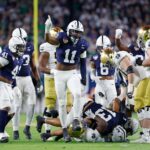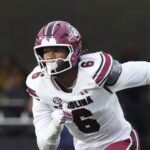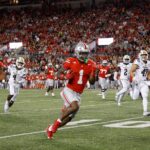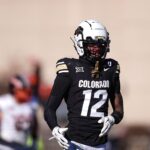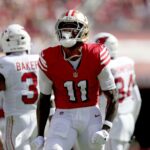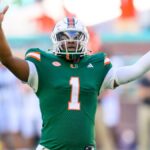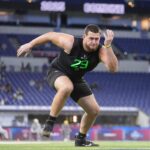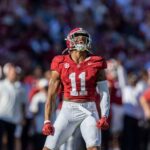[ad_1]
- Past production says a lot about a player’s potential to shine early in the NFL: Players such as Aidan Hutchinson, Jared Verse, Chase Young and Laiatu Latu parlayed strong college production into impressive rookie seasons over the past five years.
- How does the 2025 class compare? Penn State’s Abdul Carter and Marshall’s Mike Green are bringing notable college numbers to the pro ranks and project as early contributors.
Estimated Reading Time: 8 minutes
Quarterback is the most important position on a football field, but a great pass rush is the ultimate equalizer. Pressure disrupts timing, rhythm and accuracy, something only elite signal-callers can consistently overcome.
In recent years, there has been a trend of young pass rushers making more of an immediate impact in the NFL. Last season, Jared Verse of the Los Angeles Rams ranked in the top five among all pass rushers in total quarterback pressures and pass-rush win rate. The 19th overall pick in the 2024 NFL Draft ran away with the Defensive Rookie of the Year honors, garnering 36 out of a possible 49 first-place votes.
There tends to be a lot of debate this time of year when evaluating pass rushers in terms of what matters most: production at the college level or measurables from the NFL Combine/pro days. Using historical PFF data, we can draw conclusions about what matters most when projecting pass rushers.
For this piece, we’ll focus primarily on production and take a closer look at the top 10 NFL rookie edge rushers over the past five years and see how they performed in college. Following that, we’ll apply some of the context to this year’s edge class and examine who is most likely to do damage as a rookie.
These are the top 10 NFL rookie edge pass rushers in PFF pass-rush grade since the start of 2020:
| Rank | Player | Team | Year | Pass-Rush Grade | Pass-Rush Win Rate | Total Pressures |
| 1 | Micah Parsons | Cowboys | 2021 | 93.0 | 21.5% | 70 |
| 2 | Jared Verse | Rams | 2024 | 85.5 | 19.7% | 89 |
| 3 | Chop Robinson | Dolphins | 2024 | 78.7 | 18.8% | 56 |
| 4 | Will Anderson Jr. | Texans | 2023 | 76.6 | 16.4% | 68 |
| 5 | Chase Young | Commanders | 2020 | 75.9 | 10.5% | 42 |
| 6 | Laiatu Latu | Colts | 2024 | 72.1 | 14.0% | 38 |
| 7 | Alex Highsmith | Steelers | 2020 | 71.4 | 15.0% | 21 |
| 8 | Kwity Paye | Colts | 2021 | 71.3 | 12.3% | 39 |
| 9 | Aidan Hutchinson | Lions | 2022 | 70.2 | 12.4% | 53 |
| 10 | Kayvon Thibodeaux | Giants | 2022 | 67.3 | 9.7% | 45 |
Of the 10 players listed above, only Alex Highsmith (102nd overall pick) was not drafted in the first round. Only 13 of the 168 edge defenders who played at least one snap in their rookie season over the past five years rushed the passer 200-plus times and earned a 65.0-plus PFF pass-rush grade. This suggests early playing time can be hard to come by for edge rusher prospects, but those who do play tend to make an immediate impact.
Here are the same 10 players and their most productive season in college:
| Rank | Player | Team | Year | Pass-Rush Grade | Pass-Rush Win Rate | Total Pressures |
| 1 | Chase Young | Ohio State | 2019 | 96.4 | 26.6% | 56 |
| 2 | Laiatu Latu | UCLA | 2023 | 94.3 | 26.2% | 62 |
| 3 | Aidan Hutchinson | Michigan | 2021 | 93.4 | 22.5% | 74 |
| 4 | Chop Robinson | Penn State | 2022 | 92.4 | 20.9% | 48 |
| 5 | Kayvon Thibodeaux | Oregon | 2021 | 91.5 | 20.2% | 47 |
| 6 | Alex Highsmith | Charlotte | 2019 | 91.4 | 19.5% | 51 |
| 7 | Jared Verse | Florida State | 2023 | 90.8 | 21.8% | 62 |
| 8 | Kwity Paye | Michigan | 2020* | 87.1 | 21.9% | 22 |
| 9 | Micah Parsons | Penn State | 2019** | 86.8 | 20.7% | 26 |
| 10 | Will Anderson Jr. | Alabama | 2022 | 85.8 | 16.4% | 65 |
*Paye played just four games in 2020; **Parsons sat out the 2020 season due to COVID and played primarily LB in college
One thing is clear from the chart above: Edge pass rushers who made impacts as rookies in the NFL dominated in college.
With this in mind, let’s look at the top edge prospects in the 2025 NFL Draft and see who is most likely to be a difference-maker on passing downs early on in the NFL.
Abdul Carter, Penn State
Carter is the 2025 NFL Draft’s clear top pass rusher and is widely viewed as an elite prospect, capable of making a Jared Verse-like impact as a rookie, regardless of which team drafts him. There are some obvious connections to All-Pro Micah Parsons, not only because they both went to Penn State and wore No. 11, but because of their freakish athletic abilities on the field.
Abdul Carter is single-handedly taking over this game
— PFF College (@PFF_College) January 10, 2025
In terms of production on the field, Carter was in a tier of his own. This past season was his first as a full-time edge rusher, and he dominated the competition, leading the FBS in PFF pass-rushing grade (92.4) and total pressures (66) while ranking in the top five in win rate (22.6%). There is no reason to believe Carter won’t be a plug-and-play pass-rushing star from day one in the NFL.
Mike Green, Marshall
Green is one of the most intriguing prospects in this year’s draft, regardless of position. On one hand, he has only two years of starting experience and didn’t face the best competition at Marshall. On the other, his pass-rushing metrics were off the charts, ranking in the high 90th percentile in win rate.
Last season, Green led all FBS edge defenders with 17 sacks and ranked near the top in PFF pass-rushing grade (91.4) and total pressures (59). His draft stock soared when he dominated the Senior Bowl against some of the class’ best offensive tackle prospects. Green’s explosive first step combined with the violence and physicality of his moves should translate early to the NFL.
Donovan Ezeiruaku, Boston College
At 6-foot-2 and 247 pounds, Ezeiruaku is one of the smaller edge rushers in the draft, but he overcame that with a quick first step, nice bend and a high football IQ during his time at Boston College. He may not be the most explosive prospect, but there’s a smooth element to his game that allows him to consistently maximize leverage in one-on-one matchups.
What Ezeiruaku lacks in size, he more than makes up for in production. Last season, he led all FBS with 20 quarterback hits and ranked in the top five in sacks (14) and total pressures (60). His 90.5 PFF pass-rush grade also ranked in the top 10 at his respective position, and he finished his Boston College career with 140 pressures. Like Mike Green, Ezeiruaku has a strong chance to be a year-one pass-rushing contributor in the NFL.
James Pearce Jr., Tennessee
Pearce is another edge prospect who is unlikely to make it out of the first round due to his pass-rushing ability alone. His game is built on speed and anticipation, as he is quick off the ball and very twitchy in his movements.
If you look at Pearce’s 2023 and 2024 seasons, they are almost identical in terms of playing time and production. In 2023, he played 462 snaps and generated 52 pressures (91.9 PFF pass-rushing grade). And in 2024, he played 464 snaps and generated 55 pressures (89.4 PFF pass-rushing grade). His 22.4% pressure rate over the past two seasons ranks first among FBS edge defenders with at least 200 pass-rush snaps. At worst, he looks like a player who will excel as a situational rusher off the edge in the NFL.
Shemar Stewart, Texas A&M
No player improved their draft stock more at the NFL Combine than Shemar Stewart. Measuring in at 6-foot-5 and 267 pounds, the Texas A&M product had a Myles Garrett-like showing, running a 4.59-second 40-yard dash with a 40-inch vertical and a broad jump of 10 feet, 11 inches. These kinds of athletes don’t come along very often, so it’s no surprise he is getting a lot of attention leading up to the draft.
The knock on Stewart is his lack of production at the college level. His 67.1 PFF pass-rush grade in 2024 ranked 70th out of 231 draft-eligible edge defenders with at least 230 pass-rushing snaps, and his 12.4% pass-rush win rate was well below some of the other potential first-round edge prospects.
Additionally, Stewart never recorded more than 1.5 sacks in any season at Texas A&M. He has the build and athleticism of a future NFL star, but his lack of college productivity suggests he could be a work in progress as a rusher early on in his NFL career.
Mykel Williams, Georgia
Physically, Williams has the look of an NFL-caliber edge player (6-foot-5 and 265 pounds). He is coming off three highly productive years at Georgia against the top competition in the nation. Currently the No. 24-ranked prospect on PFF’s big board, Williams brings a high floor in run defense but has a lot of room to grow as a pass rusher.
Last season, he earned a 61.0 PFF pass-rush grade on true pass sets and an 11.1% win rate, metrics that were significantly lower than some of his edge prospect peers in this draft. While there are concerns about his ceiling as a pass rusher, Williams is still worthy of a first-round selection and can impact the game in other ways early on in his NFL career.
